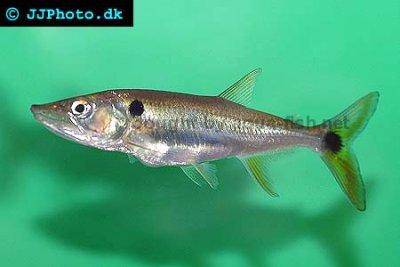Red-tail barracuda - Acestrorhynchus altus
Scientific name: Acestrorhynchus altus
Common name: Red-tail barracuda
Family: Acestrorhynchidae
Usual size in fish tanks: 20 - 24 cm (7.87 - 9.45 inch)
014
Recommended pH range: 5.5 - 7.1
Recommended water hardness: 7 - 16°N (125 - 285.71ppm)
0°C 32°F30°C 86°F
Recommended temperature range: 22 - 27 °C (71.6 - 80.6°F)
The way how these fish reproduce: Spawning
Where the species comes from: South America
Temperament to its own species: peaceful
Temperament toward other fish species: aggressive to smaller
Usual place in the tank: Middle levels
Short description
The Red-tail barracuda (Acestrorhynchus altus) is a sleek, torpedo-shaped South American characin built for fast mid-to-upper-water strikes. It’s a nervous, highly alert predator that needs a long aquarium with open lanes for sprint bursts and unobstructed turns. Best kept singly or in very large tanks with equally robust tank mates that are too large to swallow.
Origin
South America; native to the Amazon and Orinoco drainages. Typically inhabits main channels and floodplain lakes, cruising open water near the surface.
Food and feeding
An obligate fish-eater in nature. In aquaria, train onto safer prepared foods: thawed fish strips (e.g., silversides), prawn/shrimp pieces, squid, and high-quality carnivore sticks offered with feeding tongs. Avoid feeder fish due to parasites/poor nutrition; use only as a last resort while weaning. Offer moderate portions once daily and promptly remove leftovers.
Sexing
No reliable external differences are known; adult females may appear slightly fuller when gravid.
Breeding
Home-aquarium breeding is undocumented. In the wild, this species is presumed to be an egg-scattering spawner like other acestrorhynchids, with seasonal cues and extensive space requirements.
Lifespan
Typically 8–10 years with excellent water quality and an appropriate, low-stress setup.
Behavior & compatibility
Skittish and reactive; may dash when startled. Generally ignores tank mates that are too large to be eaten, but will prey on smaller fish. Conspecific tolerance is variable—can be nippy or dominant in confined quarters. If attempted, keep a small group only in very large, long tanks with visual breaks; otherwise keep singly.
Tank requirements
- Tank size: prioritize footprint/length; substantially larger than 50 gal is recommended for adults (long tanks > 150 cm).
- Aquascape: open mid/upper-water lanes; use rock/wood at the sides/back to create sightline breaks without obstructing sprints.
- Cover: tight-fitting lid—this species is jump-prone when startled.
- Water: soft, clean, well-oxygenated; pH 5.5–7.1 is fine; many keepers succeed slightly above neutral if stable.
- Temperature: Adults often do well at 24–27 °C with steady conditions.
- Filtration/flow: high turnover and strong aeration; low nitrate via regular large water changes.
Avoid routine use of feeder fish— they frequently introduce parasites and offer poor nutrition. Wean Red-tail barracuda onto thawed seafood strips and quality carnivore pellets using tongs.
Pictures
Bought by aqua-fish.net from jjphoto.dk.



